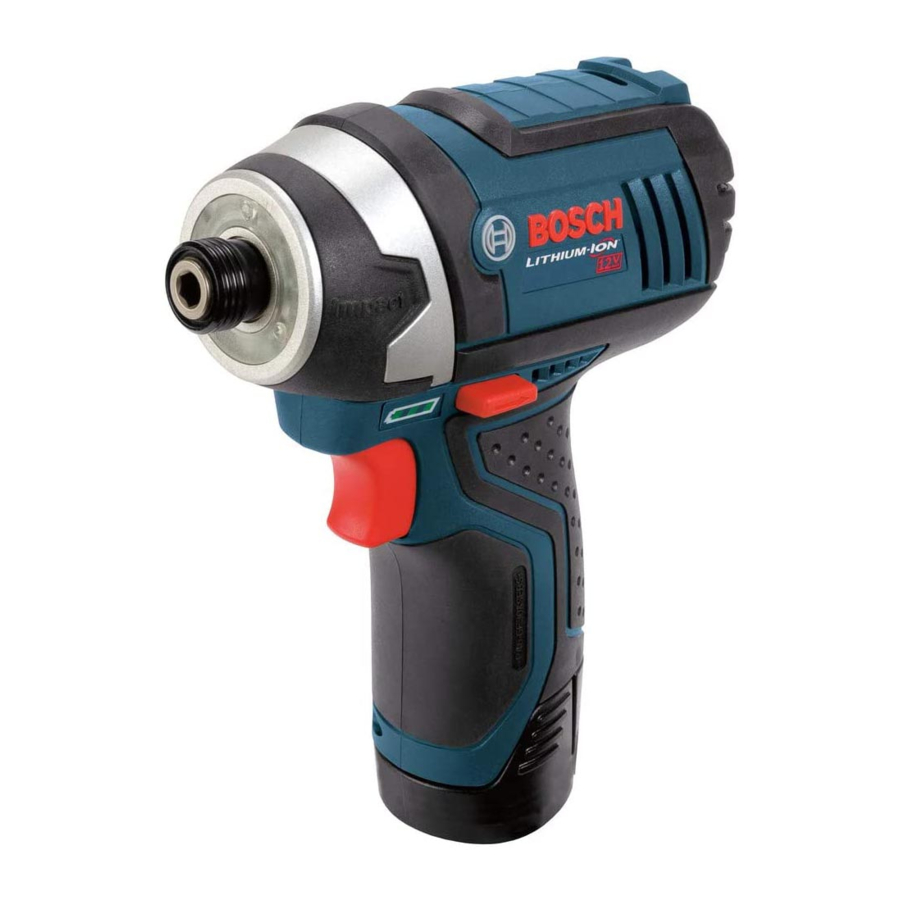
Bosch PS41 - Drill Manual
- Operating/safety instructions manual (45 pages) ,
- Operating/safety instructions manual (33 pages)
Advertisement

Safety Symbols
| The definitions below describe the level of severity for each signal word. Please read the manual and pay attention to these symbols. | |
 | This is the safety alert symbol. It is used to alert you to potential personal injury hazards. Obey all safety messages that follow this symbol to avoid possible injury or death. |
 | DANGER indicates a hazardous situation which, if not avoided, will result in death or serious injury. |
 | WARNING indicates a hazardous situation which, if not avoided, could result in death or serious injury. |
 | CAUTION indicates a hazardous situation which, if not avoided, could result in minor or moderate injury. |
General Power Tool Safety Warnings
Read all safety warnings, instructions, illustrations and specifications provided with this power tool. Failure to follow all instructions listed below may result in electric shock, fire and/or serious injury.
SAVE ALL WARNINGS AND INSTRUCTIONS FOR FUTURE REFERENCE
The term "power tool" in the warnings refers to your mains-operated (corded) power tool or battery-operated (cordless) power tool.
Work area safety
Keep work area clean and well lit. Cluttered or dark areas invite accidents.
Do not operate power tools in explosive atmospheres, such as in the presence of flammable liquids, gases or dust. Power tools create sparks which may ignite the dust or fumes.
Keep children and bystanders away while operating a power tool. Distractions can cause you to lose control.
Electrical safety






Personal safety
Stay alert, watch what you are doing and use common sense when operating a power tool. Do not use a power tool while you are tired or under the influence of drugs, alcohol or medication. A moment of inattention while operating power tools may result in serious personal injury.
Use personal protective equipment. Always wear eye protection. Protective equipment such as dust mask, non-skid safety shoes, hard hat, or hearing protection used for appropriate conditions will reduce personal injuries.
Prevent unintentional starting. Ensure the switch is in the off-position before connecting to power source and / or battery pack, picking up or carrying the tool. Carrying power tools with your finger on the switch or energizing power tools that have the switch on invites accidents.
Remove any adjusting key or wrench before turning the power tool on. A wrench or a key left attached to a rotating part of the power tool may result in personal injury.
Do not overreach. Keep proper footing and balance at all times. This enables better control of the power tool in unexpected situations.
Dress properly. Do not wear loose clothing or jewelry. Keep your hair, clothing and gloves away from moving parts. Loose clothes, jewelry or long hair can be caught in moving parts.
If devices are provided for the connection of dust extraction and collection facilities, ensure these are connected and properly used. Use of dust collection can reduce dust-related hazards.
Do not let familiarity gained from frequent use of tools allow you to become complacent and ignore tool safety principles. A careless action can cause severe injury within a fraction of a second.
Power tool use and care
Do not force the power tool. Use the correct power tool for your application. The correct power tool will do the job better and safer at the rate for which it was designed.
Do not use the power tool if the switch does not turn it on and off. Any power tool that cannot be controlled with the switch is dangerous and must be repaired.
Disconnect the plug from the power source and/or remove the battery pack, if detachable, from the power tool before making any adjustments, changing accessories, or storing power tools. Such preventive safety measures reduce the risk of starting the power tool accidentally.
Store idle power tools out of the reach of children and do not allow persons unfamiliar with the power tool or these instructions to operate the power tool. Power tools are dangerous in the hands of untrained users.
Maintain power tools and accessories. Check for misalignment or binding of moving parts, breakage of parts and any other condition that may affect the power tool's operation. If damaged, have the power tool repaired before use. Many accidents are caused by poorly maintained power tools.
Keep cutting tools sharp and clean. Properly maintained cutting tools with sharp cutting edges are less likely to bind and are easier to control.
Use the power tool, accessories and tool bits etc. in accordance with these instructions, taking into account the working conditions and the work to be performed. Use of the power tool for operations different from those intended could result in a hazardous situation.
Keep handles and grasping surfaces dry, clean and free from oil and grease. Slippery handles and grasping surfaces do not allow for safe handling and control of the tool in unexpected situations.
Battery tool use and care


When battery pack is not in use, keep it away from other metal objects like paper clips, coins, keys, nails, screws, or other small metal objects that can make a connection from one terminal to another. Shorting the battery terminals together may cause burns or a fire.
Under abusive conditions, liquid may be ejected from the battery, avoid contact. If contact accidentally occurs, flush with water. If liquid contacts eyes, additionally seek medical help. Liquid ejected from the battery may cause irritation or burns.

Do not expose a battery pack or tool to fire or excessive temperature. Exposure to fire or temperature above 265°F may cause explosion.

Service
Have your power tool serviced by a qualified repair person using only identical replacement parts. This will ensure that the safety of the power tool is maintained.
Never service damaged battery packs. Service of battery packs should only be performed by the manufacturer or authorized service providers.
Safety Rules for the Product

Brace the tool properly before use. This tool produces a high output torque and without properly bracing the tool during operation, loss of control may occur resulting in personal injury.
Wear ear protectors when using the tool for extended periods. Prolonged exposure to high intensity noise can cause hearing loss.
Use auxiliary handle(s) if supplied with the tool. Loss of control can cause personal injury.
Use clamps or another practical way to secure and support the workpiece to a stable platform. Holding the work by hand or against your body leaves it unstable and may lead to loss of control.
Do not drill, fasten or break into existing walls or other blind areas where electrical wiring may exist. If this situation is unavoidable, disconnect all fuses or circuit breakers feeding this worksite.
Always wear safety goggles or eye protection when using this tool.
Use thick cushioned gloves and limit the exposure time by taking frequent rest periods. Vibration caused by hammer-drill action may be harmful to your hands and arms.
Secure the material being fastened. Never hold it in your hand or across your legs. Unstable support can cause loss of control and injury.
Avoid accidental starting. Be sure the forward/reverse switch is in the off position before inserting battery pack. Carrying appliances with your finger on the switch or inserting the battery pack into an appliance with the switch on invites accidents.
Remove battery pack before changing accessories. Accidental starting may occur because battery appliances with a battery inserted are in the operative condition.
Be prepared for a reaction torque when "seating" or removing a fastener. The screwdriver housing may tend to twist in the opposite direction of bit rotation when "seating" or removing a fastener depending on the torque setting of the tool.
Do not use dull or damaged bits and accessories. When installing an accessory, insert the shank of the bit well within the chuck. Be sure the chuck has locked onto the bit correctly.
Do not run the tool while carrying it at your side. A spinning bit could become entangled with clothing and injury may result.
Place the tool onto the fastener only when the screwdriver is switched off. Rotating driver tools can slide off the fastener.
Do not use this tool as a drill. Tools equipped with shut-off clutches are not designed for drilling applications. The clutch can shut off automatically and without warning.
Be careful when driving long screws – there is a risk of sliding off the fastener head depending on type of socket or bit used. First test the run-down of a fastener and pay attention during the screw driving process to ensure you do not injure yourself if the tool bit or socket slides off of the fastener.
Additional Safety Warnings
GFCI and personal protection devices like electrician's rubber gloves and footwear will further enhance your personal safety.
Do not use AC only rated tools with a DC power supply. While the tool may appear to work, the electrical components of the AC rated tool are likely to fail and create a hazard to the operator.
Keep handles dry, clean and free from oil and grease. Slippery hands cannot safely control the power tool.
Develop a periodic maintenance schedule for your tool. When cleaning a tool be careful not to disassemble any portion of the tool since internal wires may be misplaced or pinched or safety guard return springs may be improperly mounted. Certain cleaning agents such as gasoline, carbon tetrachloride, ammonia, etc. may damage plastic parts.
Ensure the switch is in the off position before inserting battery pack. Inserting the battery pack into power tools that have the switch on invites accidents.
Some dust created by power sanding, sawing, grinding, drilling, and other construction activities contains chemicals known to cause cancer, birth defects or other reproductive harm. Some examples of these chemicals are:
- Lead from lead-based paints,
- Crystalline silica from bricks and cement andother masonry products, and
- Arsenic and chromium from chemically-treated lumber.
Your risk from these exposures varies, depending on how often you do this type of work. To reduce your exposure to these chemicals: work in a well ventilated area, and work with approved safety equipment, such as those dust masks that are specially designed to filter out microscopic particles.
Symbols
Some of the following symbols may be used on your tool. Please study them and learn their meaning. Proper interpretation of these symbols will allow you to operate the tool better and safer.
| Symbol | Designation / Explanation |
| V | Volts (voltage) |
| Ah | Amp hour (measurement of battery capacity) |
| A | Amperes (current) |
| Hz | Hertz (frequency, cycles per second) |
| W | Watt (power) |
| kg | Kilograms (weight) |
| min | Minutes (time) |
| s | Seconds (time) |
| ⌀ | Diameter (size of drill bits, grinding wheels, etc.) |
| n0 | No load speed (rotational speed at no load) |
| n | Rated speed (maximum attainable speed) |
| .../min | Revolutions or reciprocation per minute (revolutions, strokes, surface speed, orbits etc. per minute) |
| 0 | Off position (zero speed, zero torque...) |
| 1, 2, 3, ... I, II, III, | Selector settings (speed, torque or position settings. Higher number means greater speed) |
 | Infinitely variable selector with off (speed is increasing from 0 setting) |
 | Arrow (action in the direction of arrow) |
 | Alternating current (type or a characteristic of current) |
 | Direct current (type or a characteristic of current) |
 | Alternating or direct current (type or a characteristic of current) |
 | Class II construction (designates double insulated construction tools) |
 | Earthing terminal (grounding terminal) |
 | Alerts user to wear eye protection |
Functional Description and Specifications
Disconnect battery pack from tool or place the switch in the locked or off position before making any assembly, adjustments or changing accessories. Such preventive safety measures reduce the risk of starting the tool accidentally.
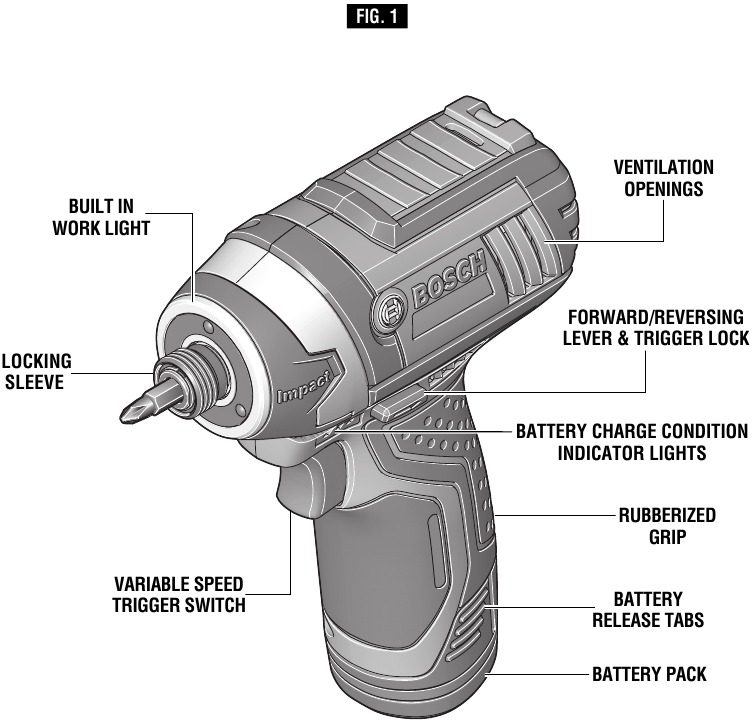
Cordless Impact Driver PS41 (FIG. 1)
| Model number | PS41 |
| Voltage rating | 10.8V/12V  MAX MAX |
| No load speed | n0 0-2,600/min |
| Impact rate | 0-3,100/min |
| Maximum Capacities | |
| Chuck size | 1/4" Hex-shank with power groove |
| Screw sizes | 5/16" (8 mm) |
| Allowed ambient temperature | |
| – during charging | 32...113°F (0...+45°C) |
| – during operation/storage | –4...122°F (–20...+50°C) |
Battery Packs/Chargers
Please refer to the battery/charger list, included with your tool.
Operating Instructions
INTENDED USE
This tool is intended for the fastening and loosening of bolts, nuts and various threaded fasteners. This tool is not intended for use as a drill.
The Bosch model PS41 Cordless Impact Driver has a collet that accepts only standard 1/4" hexagonal shank accessories with power groove. The low RPM capability of this model is not a deficiency. On the contrary, low speed means high torque and high torque is a definite plus for efficient drilling and driving. The low speed also provides more control to prevent stripout of the screw and damage to the work surface.
INSERTING AND REMOVING ACCESSORIES
To avoid loss of control, ensure bit is locked in chuck by pulling on bit after it has been inserted.
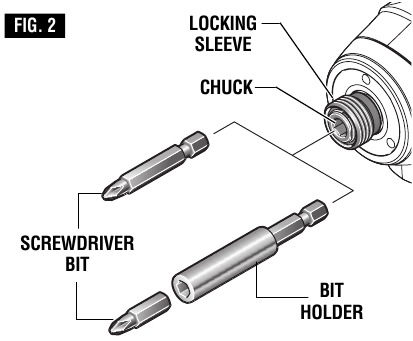
Your tool is equipped with a quick release chuck. To insert an accessory, simply pull locking sleeve forward, insert desired accessory into chuck and release locking sleeve (Fig. 2).
To remove an accessory, pull locking sleeve forward and simply remove it from the chuck.
Do not use this tool as a drill. Tools equipped with shut-off clutches are not designed for drilling applications. The clutch can shut off automatically and without warning. Attempting to restart drilling after shut-off has been reached can cause the tool to twist out of your hand until the clutch again reaches shut-off. Do not attempt to insert quick-change type drill bits into this chuck.
VARIABLE SPEED CONTROLLED TRIGGER SWITCH
Your tool is equipped with a variable speed trigger switch. The tool can be turned "ON" or "OFF" by squeezing or releasing the trigger. The speed can be adjusted from the minimum to maximum nameplate RPM by the pressure you apply to the trigger. Apply more pressure to increase the speed and release pressure to decrease speed (Fig. 1).
BRAKE
When the trigger switch is released it activates the brake to stop the chuck quickly. This is especially useful in the repetitive driving and removal of screws.
FORWARD/REVERSING LEVER & TRIGGER LOCK
After tool use, lock trigger in "OFF" position to help prevent accidental starts and accidental discharge.
Your tool is equipped with a forward/ reversing lever and trigger lock located above the trigger (Fig. 3). This lever was designed for changing rotation of the bit, and for locking the trigger in an "OFF" position.
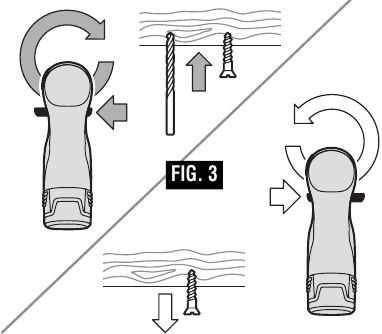
For forward rotation, (with chuck pointed away from you) move the lever to the far left.
For reverse rotation move the lever to the far right. To activate trigger lock move lever to the center off position.
Do not change direction of rotation until the tool comes to a complete stop. Shifting during rotation of the chuck can cause damage to the tool.
BUILT IN WORK LIGHT
Your tool is also equipped with a light that turns on automatically when the switch is activated, for better visibility when drilling/driving (Fig. 1).
BATTERY CHARGE CONDITION INDICATOR LIGHTS
Your tool is equipped with charge condition indicator lights (Fig. 1). The indicator lights shows the charge condition of the battery for a few second when the On/Off trigger is pressed halfway or fully.
| LED | Capacity |
| Continuous lighting 3 x green | > 2/3 |
| Continuous lighting 2 x green | > 1/3 |
| Continuous lighting 1 x green | < 1/3 |
| Flashing light 1 x green | reserve |
INSERTING AND RELEASING BATTERY PACK
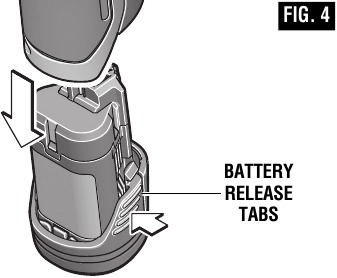
Release battery pack from tool by pressing on both sides of the battery release tabs and pull downward (Fig. 4).
To insert battery, align battery and slide battery pack into tool until it locks into position. Do not force.
If battery release tabs are cracked or otherwise damaged, do not insert into tool. Battery can fall out during operation.
Operating Tips
DRIVING WITH VARIABLE SPEED
The technique is to start slowly, increasing the speed as the screw runs down. Set the screw snug ly by slowing to a stop. Prior to driving screws, pilot and clearance holes should be drilled.
Always hold the machine straight on the bolt to be tightened.
The best method to determine the right impacting/tightening duration is by means of a trial. For small screws, the impacting/tightening duration can be reached in less then 0.5 Sec. Therefore, work with low RPM and switch the machine off immediately when the screw is tight and the impacting sound can be heard.
For screwing larger, longer wood screws into hard material, pre-drilling is the best method.
TIGHTENING TORQUE
The tightening torque depends on the duration of the impacting/tightening action. The largest tightening torque is achieved after approx. 6 to 10 Sec. impacting/tightening action.
The torque build-up depends on the following factors:
- Hardness of the bolts/nuts.
- Type of washer (disk washer, spring washer, seal).
- Hardness of the material to be joined.
- Lubricating effect at the surfaces of the junction.
This leads to the following application cases:
Hard case: The joining of metal to metal with a disk washer. The maximum torque is reached after a relative short impacting/ tightening action.
Medium case: The joining of metal to metal where spring ring washer, disk spring washer, stud bolts or bolts/nuts with conical seats are used.
Soft case: The joining of e.g. metal to wood or insulation material.
For middle or soft joining cases, the maximum tightening torque is less as for hard cases. Therefore, a longer impacting/tightening action is necessary to arrive at the maximum tightening torque.
FASTENING WITH SCREWS
This procedure shown in (Fig. 7) will enable you to fasten ma terials together with your tool without stripping, splitting or separating the material.
First, clamp the pieces together and drill the first hole 2/3 the diam eter of the screw. If the material is soft, drill only 2/3 the proper length. If it is hard, drill the entire length.
Second, unclamp the pieces and drill the second hole the same diameter as the screw shank in the first or top piece of wood.
Third, if flat head screw is used, countersink the hole to make the screw flush with the surface. Then, simply apply even pressure when driving the screw. The screw shank clearance hole in the first piece allows the screw head to pull the pieces tightly together.

DRIVING NUTS AND BOLTS
Variable speed control must be used with caution for driving nuts and bolts with socket set attach ments. The technique is to start slowly, increasing speed as the nut or bolt runs down. Set the nut or bolt snugly by slowing the drill to a stop. If this procedure is not followed, the tool will have a tendency to torque or twist in your hands when the nut or bolt seats.
Maintenance
To avoid accidents, always disconnect the tool and/or charger from the power supply before servicing or cleaning.
Service
NO USER SERVICEABLE PARTS INSIDE.
Preventive maintenance performed by unauthorized personnel may result in misplacing of internal wires and components which could cause serious hazard. We recommend that all tool service be performed by a Bosch Factory Service Center or Authorized Bosch Service Station.
SERVICE MEN: Disconnect tool and/or charger from power source before servicing.
BATTERIES
Be alert for battery packs that are nearing their end of life. If you notice decreased tool performance or significantly shorter running time between charges then it is time to replace the battery pack. Failure to do so can cause the tool to operate improperly or damage the charger.
TOOL LUBRICATION
Your Bosch tool has been properly lubricated and is ready for use.
D.C. MOTORS
The motor in your tool has been engineered for many hours of dependable service. To maintain peak efficiency of the motor, we recommend it be examined every six months. Only a genuine Bosch replacement motor specially designed for your tool should be used.
BEARINGS
Bearings which become noisy (due to heavy load or very abrasive material cutting) should be replaced at once to avoid overheating and motor failure.
Cleaning
Certain cleaning agents and solvents damage plastic parts. Some of these are: gasoline, car bon tetrachloride, chlorinated cleaning solvents, ammonia and household detergents that contain ammonia.
Ventilation openings and switch levers must be kept clean and free of foreign matter. Do not attempt to clean by inserting pointed objects through opening.
1-877-BOSCH99 (1-877-267-2499) www.boschtools.com
Documents / Resources
References
Download manual
Here you can download full pdf version of manual, it may contain additional safety instructions, warranty information, FCC rules, etc.
Advertisement




















Need help?
Do you have a question about the PS41 and is the answer not in the manual?
Questions and answers